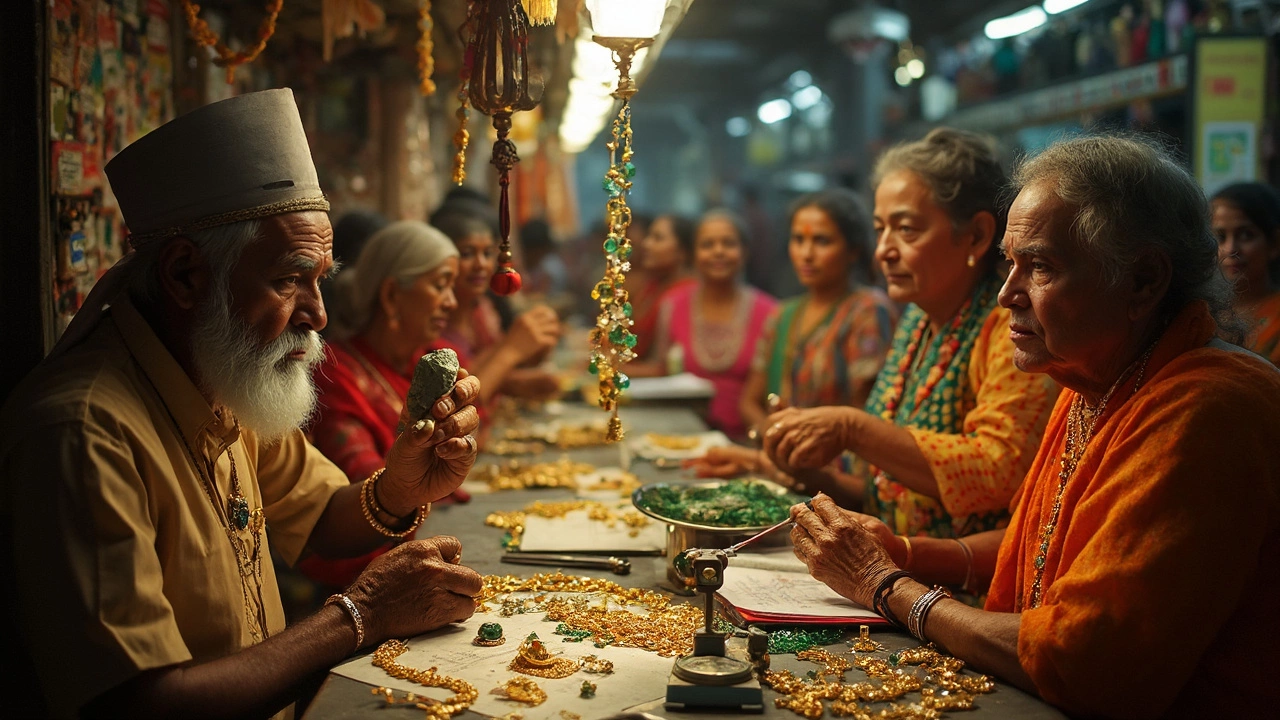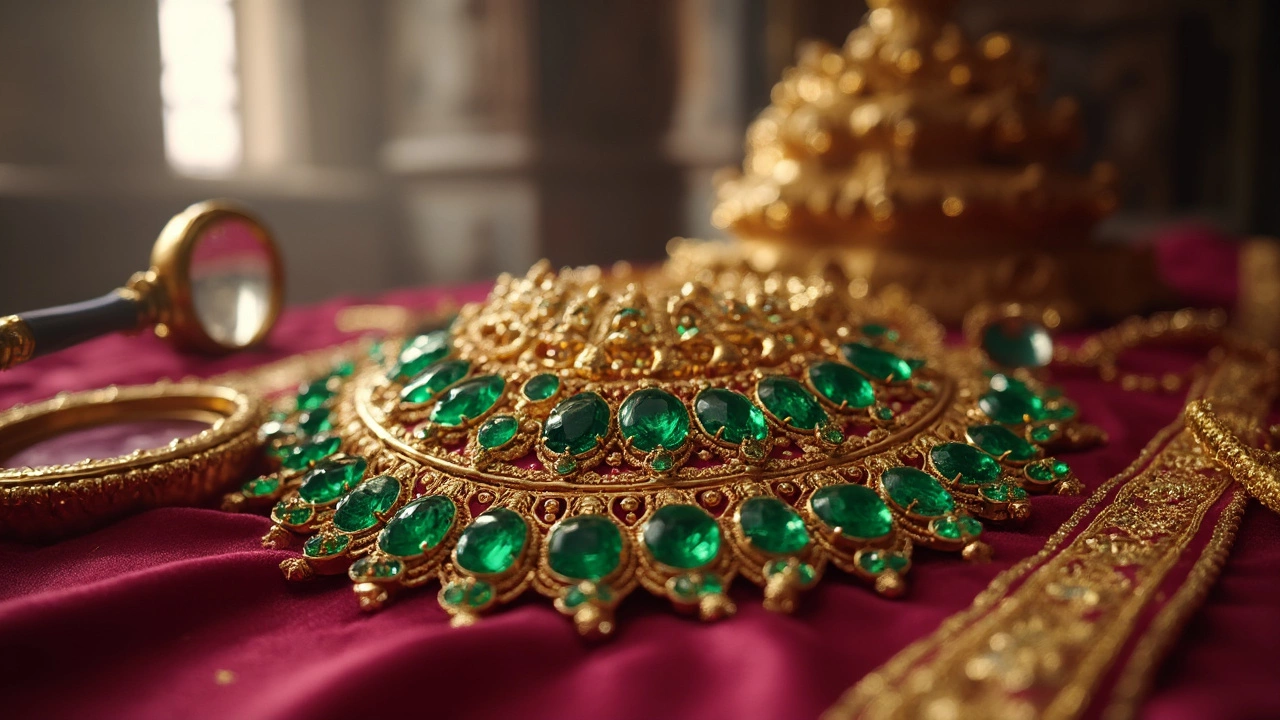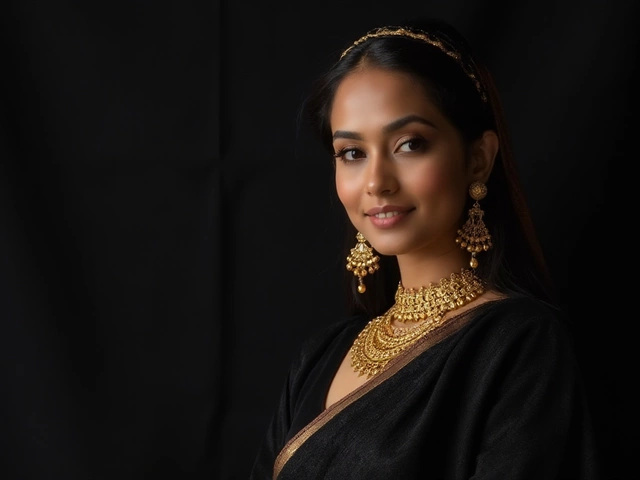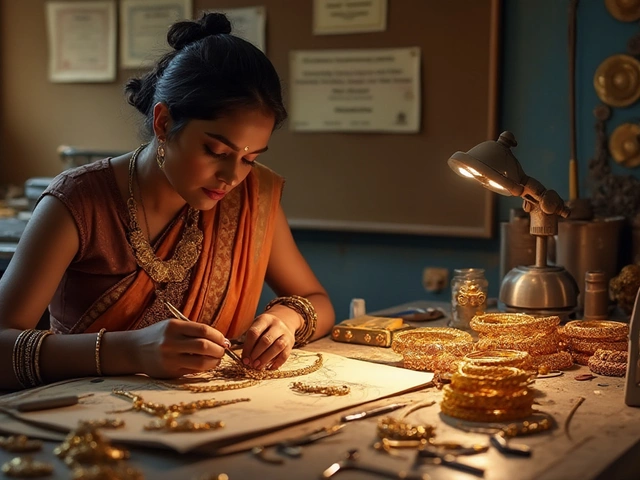Ever checked out a heavy South Indian temple necklace and wondered—"Is that bright green gem an emerald, and how much does it actually cost here?" Real emerald isn’t cheap in India, especially when it’s set in traditional temple jewellery. Prices can swing a lot, depending on quality, size, and where you’re buying. Don’t assume all green stones in jewellery are emerald—even seasoned shoppers sometimes get tricked by lookalikes like green onyx or glass.
If you plan to buy temple jewellery with emeralds, you need to know what really drives up the price. The story isn’t just about rarity. It’s about colour intensity, clarity, and origin (Colombian and Zambian emeralds are usually prized higher than local Indian stones). On top of that, big jewellers in Chennai or Hyderabad mark up prices much more than small shops in Kerala or Rajasthan. Knowing these details will help you buy smarter, and avoid burning a hole in your pocket for a stone that isn’t even the real deal.
- Why Emerald Costs What It Does in India
- Emeralds in Temple Jewellery: Tradition Meets Trend
- How to Check If an Emerald Is Worth the Price
- Tips for Smart Emerald Shopping in India
Why Emerald Costs What It Does in India
Emerald prices in India aren’t pulled out of thin air. They mostly depend on where the stone comes from, how clear and deep the green is, and, of course, how big it is. People in the market usually look for stones with a strong, even green colour—that’s what fetches the big money. You’ll see that Colombian emeralds, because of their pure green colour and fewer cracks, always top the price charts. Zambian emeralds are the next big thing, offering a slightly bluish green sparkle, usually for a bit less money.
Local Indian emeralds, especially from Rajasthan, can look nice but tend to have more spots and cracks. This brings the price down, so if you spot a "cheap" emerald, it’s probably not from Colombia or Zambia, or it has visible flaws. Now, here’s the thing: most real, quality emeralds in Indian temple jewellery are imported because the best stuff isn’t found in bulk here. That’s another reason prices stay high.
Let’s make this clearer—check out the common price ranges for emerald stones in 2024:
| Origin | Quality | Typical Price (per carat, in INR) |
|---|---|---|
| Colombia | Premium | 40,000 - 2,00,000 |
| Zambia | Medium to High | 15,000 - 80,000 |
| India (Rajasthan) | Low to Medium | 2,500 - 35,000 |
There’s also the cut and transparency to think about. A well-cut emerald, even if it’s not super big, will be priced higher than a larger, badly cut one. Jewellers love to talk up the weight, but even a few carats can mean nothing if the stone is full of cloudy patches.
Now, if you’re actually checking prices for temple jewellery, the setting can make a difference of 10% to even 30%. Handcrafted gold or antique designs push up the rate—not just of the emerald, but the overall piece.
- If you’re quoted suspiciously low rates, be careful—it’s probably glass or just a green stone passed off as emerald.
- Always ask for a lab certificate. Any serious jeweller in India will have one if they’re selling genuine emeralds.
- Remember, prices keep changing because of market demand, import costs, and even the strength of the rupee.
Knowing exactly what affects emerald prices helps you bargain better, spot fakes, and pick stones that are actually worth the spend.
Emeralds in Temple Jewellery: Tradition Meets Trend
Temple jewellery and emeralds go way back, especially in South India. You’ll spot real emeralds in elaborate necklaces, chokers, and jhumkas worn by classical dancers and even during big pujas. In olden days, these gems were mostly reserved for royalty and temples because of their rich green colour and price tag. The reason? Green was considered lucky and was thought to bring prosperity.
Today, when you check out temple jewellery from places like Kanchipuram, Tirupati, or Chettinad, emeralds still feature as the centrepiece. But there’s a twist—modern designs are mixing old motifs with trendier layouts, so you get the best of both worlds: centuries-old meaning and up-to-date style. Some of the most popular temple jewellery styles packed with emeralds include:
- Grand harams with bold green stones set among gold Goddess motifs
- Kasumala (coin necklaces) where small emeralds highlight the coins
- Chandbalis and jhumkas that combine emerald with rubies and pearls
- Waistbands (vaddanams) for bridal wear studded with rows of green gems
But not every green stone in temple jewellery is a genuine emerald. Many affordable sets use hydrothermal or lab-grown stones, or sometimes just green glass to keep costs in check. If you’re uncertain, always ask if the stone is natural, treated, or synthetic.
Take a look at actual data for how much emeralds add to the value of traditional temple jewellery in top Indian cities:
| City | Average Cost (per carat for real emerald) | Extra Gold Jewellery Cost With Emerald Setting |
|---|---|---|
| Chennai | ₹5,000 - ₹45,000 | 10%-30% jump vs. plain gold |
| Hyderabad | ₹4,500 - ₹40,000 | 12%-28% extra |
| Bangalore | ₹6,000 - ₹50,000 | 15%-35% extra |
If you’re shopping or just admiring, know that the classic look of temple jewellery with emeralds isn’t just about style. It’s a signal of heritage, wealth, and the never-fading appeal of green in Indian culture. Plus, with modern buyers wanting a dash of tradition without looking old-fashioned, these emerald-studded designs stay in big demand.

How to Check If an Emerald Is Worth the Price
If you're serious about buying an emerald, especially for temple jewellery, you can’t just rely on the shopkeeper’s word. There are a few things you absolutely need to check before paying the big bucks, because a lot of seemingly fancy stones in India are actually not natural emeralds at all.
- Colour: Look for a rich, even green that’s not too dark or too pale. Top-quality stones have a bold, vivid green with a slight bluish or yellowish tint, but never a muddy look.
- Clarity: Natural emeralds almost always have some inclusions (tiny marks or cracks inside). If you see a stone that’s too perfect, it might be synthetic or heavily treated. Some flaws are normal—totally clear emeralds fetch sky-high prices.
- Cut: The shape and finish of the stone matters. Bad cuts can make a stone look dull even if it’s genuine. Well-cut emeralds have nice proportions and show off the colour evenly.
- Origin: Stones from Colombia usually cost the most, followed by Zambian and then Indian emeralds. Dealers will often mention this in the certificate, but always double-check with a reliable lab report.
Here’s a handy table of real-world prices in India so you know what to expect, based on shop data from 2024:
| Emerald Quality | Origin | Price per Carat (INR) |
|---|---|---|
| Premium | Colombia | 60,000 - 1,80,000 |
| High | Zambia | 35,000 - 75,000 |
| Standard | India | 7,000 - 25,000 |
Always ask for a gemstone certificate from a trustworthy lab like GIA, IGI, or even a known Indian gem testing centre. Genuine certificates will mention if the stone is untreated, oiled, or anything else important. Never fall just for a fancy box or big promises. One last tip: hold the emerald against a white sheet. If the green looks bright and lively, you’re on the right track. If it looks dull or glassy, think again. Buy from jewellers who take returns and don’t mind you double-checking with your own trusted gemologist.
Tips for Smart Emerald Shopping in India
Shopping for an emerald in India—especially for temple jewellery—calls for a sharp eye and some solid homework. Not every green stone is worth your money, and not every price tag reflects the real deal. Here’s how you can make sure you’re not getting ripped off and that your gem is truly special.
- Ask for Certification: Always buy emeralds that come with a gemological certificate. Look for labs like IGI (International Gemological Institute) or GIA (Gemological Institute of America), not random ‘in-house’ stickers. If a seller refuses, that's a huge red flag.
- Check for Treatments: Nearly all emeralds are treated with oils to fill cracks and make them look better. But heavily treated emeralds are less valuable. Ask directly about treatments—many sellers won’t tell you unless you push.
- Compare Prices: There’s no shame in checking prices at big reputed stores and then visiting small local jewellers. You might see differences of 30-40% even for similar quality stones, especially in places like Hyderabad’s Charminar market or Chennai’s T. Nagar.
- Understand Colour and Clarity: Deep, even green gets top prices. Too dark or too light? Price drops. Stones with visible cracks and black specks (called "jardin") are cheaper, but too many of these flaws make the gem weak and less sparkly.
- Beware of Fakes: Sadly, fakes are common. Glass, synthetic, or dyed stones get passed off as emerald. Real emerald will feel cool to the touch, have natural inclusions (not bubbles!), and weigh a bit less than a glass fake of the same size.
- Negotiate: Gemstone prices aren’t fixed in most Indian markets. Don’t shy away from bargaining, but set a budget and stick to it. If something feels off, walk away.
For a quick reference, here’s what emerald prices can look like in 2025 across different places and qualities in India:
| Emerald Quality | Origin | Typical Price per Carat (INR) | Where to Buy |
|---|---|---|---|
| High (Vivid Green, Excellent Clarity) | Colombia/Zambia | ₹60,000 - ₹1,50,000 | Top jewellers (Tanishq, Malabar, Kalyan) |
| Mid (Good Colour, Minor Inclusions) | Brazil/India | ₹20,000 - ₹50,000 | Local jewellers, gemstone dealers |
| Low (Light Colour, Many Inclusions) | India | ₹2,000 - ₹15,000 | Markets (Charminar, Chandni Chowk, Kerala’s Kozhikode) |
Always remember: if a price looks too good to be true, it probably is. Ask around, do your own checks, and when in doubt, leave it out. Temple jewellery is an investment—don’t rush it.



